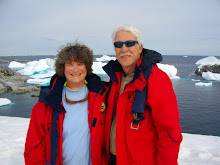WWF wastes CO2, but you have to cut back
The rules are different for the eco-royalty:
JunkScience.com -- Steven Milloy, Publisher:
Move over Al Gore. Swankier carbon charlatanism has come to town in the form of the World Wildlife Fund’s luxury getaway called "Around the World: A Private Jet Expedition."What are the rules for the rest of us?
"Join us on a remarkable 25-day journey by luxury private jet," invites the WWF in a brochure for its voyage to "some of the most astonishing places on the planet to see top wildlife, including gorillas, orangutans, rhinos, lemurs and toucans."
For a price tag that starts at $64,950 per person, travelers will meet at the Ritz-Carlton in Orlando, Fla. on April 6, 2009 and then fly to “remote corners” of the world on a “specially outfitted jet that carries just 88 passengers in business-class comfort.” “World class experts — including WWF’s director of species conservation — will provide lectures en route, and a professional staff will be devoted to making your global adventure seamless and memorable.” Travelers will visit the Amazon Rain Forest in Brazil, Easter Island, Samoa, Borneo, Laos, Nepal, Madagascar, Namibia, Uganda or Rwanda, and finish up at the luxury Dorchester Hotel in London.
This is the very same WWF that says “the current growth in [carbon dioxide] emissions must be stopped as soon as possible” and that blames Americans for emitting 21 percent of global CO2 emissions even though the U.S. accounts for only 5 percent of the global population. In December 2007, the WWF launched its “Earth Hour” campaign, a global initiative in which cities and communities simultaneously turn out their lights for one hour “to symbolize their leadership and commitment to finding solutions for climate change.”
So how does this fantasy trip square with the WWF’s alarmist rhetoric?
Using the carbon footprint calculator on the WWF’s own web site, the 36,800-mile trip in a Boeing 757 jet will burn about 100,000 gallons of jet fuel to produce roughly 1,231 tons of CO2 in 25 days — that’s the equivalent of putting about 1,560 SUVs on the road during those three-plus weeks and that doesn’t even include emissions related to local air, ground and water transport and other amenities.
The WWF laments on its web site that the average American produces 19.6 tons of CO2 annually, which is nearly five times the world average of 3.9 tons per person. But during the WWF’s posh excursion, travelers will produce 14 tons of CO2 per person. That’s 71 percent of the average American carbon footprint and 360 percent of the average global footprint in a mere three-and-one-half weeks. But who’s counting — especially when you’re in “19 rows of spacious leather seats with full ergonomic support” enjoying “gourmet meals, chilled champagne [and] your own chef.”
I guess those are the rules when you’re one of WWF’s wealthy donors, but now contrast this with the how the WWF says the rest of us should live our lives. The group’s web site states that “It clearly is time for all Americans to roll up their sleeves, to take steps to reduce emissions, to prepare for climate change, and to encourage others to do the same.”On a day trip from Bangkok last year we met a man who works for WWF in Indonesia. I am asking him to explain this.
We, the masses, should — nay, must — use compact fluorescent light bulbs, reduce hot water use, turn thermostats down in the winter and up in the summer and use low-flow shower heads and faucets. We should pledge to commute by car pool or mass transit, switch to “green power,” and get more fuel efficient cars. We should make our lives more expensive and less convenient so that the Green elites don’t feel too guilty while jet-setting to exotic locales.
Maybe, you’re thinking, the WWF plans to makes its trip “carbon neutral” by purchasing carbon offsets — after all, the group does offer a carbon offset calculator on its web site under the heading “Join WWF in our mission to save life on Earth.” But neither the trip brochure nor the WWF web site mentions that any offsets will be purchased — and there seems to be good reason for that.
According to the WWF’s calculator, it would cost in excess of $44,000 to offset the carbon emissions from the jet travel alone. Then there’s the September 2008 report from the General Accounting Office which concluded that the carbon offset market lacked credibility....


0 Comments:
Post a Comment
<< Home